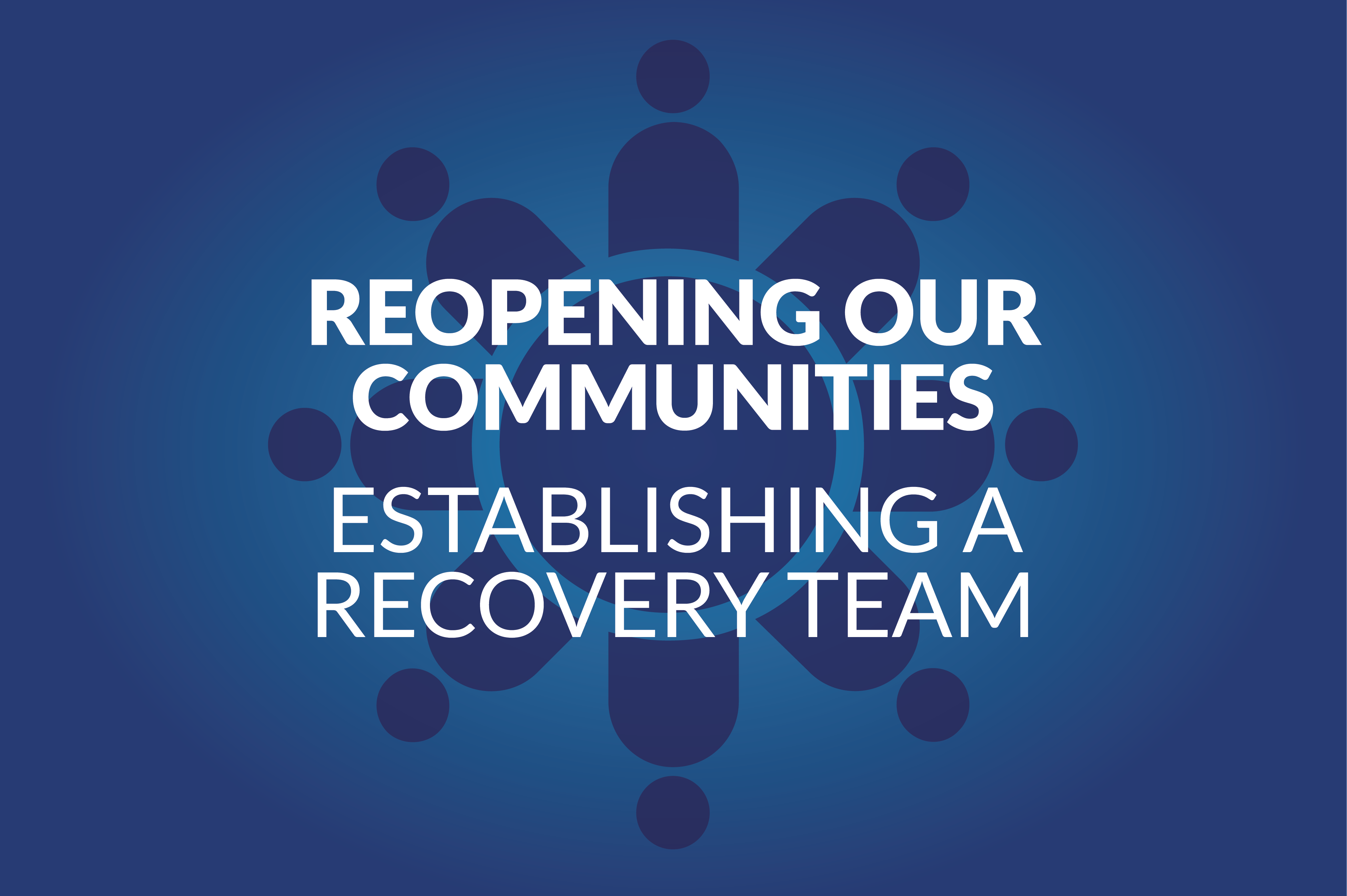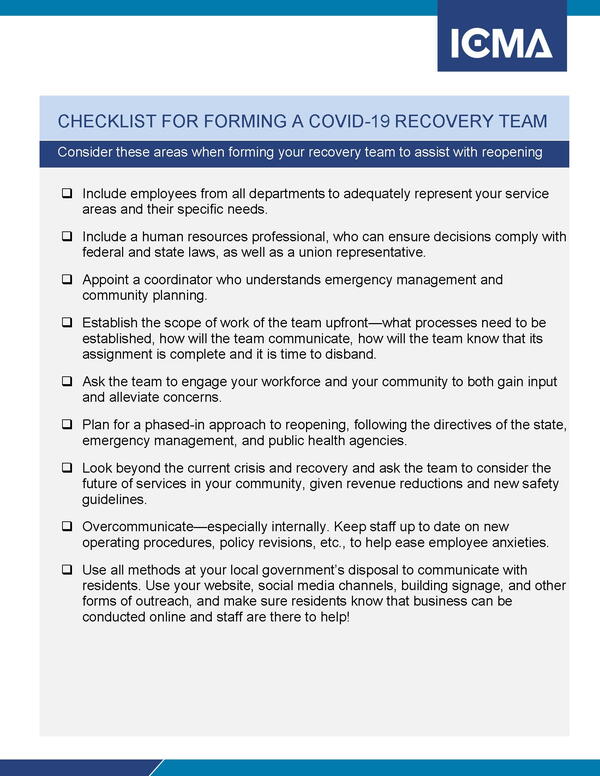
As COVID-19 restrictions are slowly being lifted around the world, it's important to develop plans to reopen government-owned facilities to receive employees and the public. Creating a task force, or a recovery team, of local government employees can help guide and inform how best to reopen your town hall and other local government facilities. Whether you have 10 or 10,000 employees, an internal team can dedicate time to work through the minute details of a reopening strategy, help represent a multitude of departmental and service delivery concerns, comprehensively address community needs, and help to address the anxieties of your employees and your customers/stakeholders.
Consider the following when creating your own recovery team:
Who will be on your recovery team?
-
Include employees from all departments to adequately represent your service areas and their specific needs. Protocols will need to vary between field and office staff, so having direct insight from across departments will help to inform all aspects of your plan for reopening. Begin by casting a wide net to include senior staff, key program managers, and those on the front lines of service who often have the greatest insights into improving your service delivery.
-
Include your human resource professionals, who can ensure decisions comply with federal and state laws, your personnel/HR policies, and labor agreements. Consider appointing union representatives or at least providing a forum for their input into the process.
-
Establish one individual as the recovery team/reopening coordinator and point-person to oversee planning and departmental actions. Ideally, this should be a leader who understands both emergency management and community planning.
What is the recovery team’s scope of work?
-
What processes and procedures are required to promote a safe transition to the “new normal” that must be addressed?
-
How will the team communicate with internal and external stakeholders, and how frequent will that communication be?
-
When will you know the team is ready to disband or is no longer needed?
-
Recovery teams will need to consider employee reintegration and wellbeing, changes required to the physical infrastructure of facilities, permanent changes to operations, mitigation and response for a potential next wave of the virus, and outreach and communication to the community and your staff. Depending on the size of your recovery team, these topics could be addressed through smaller subteams.
-
In the spirit of engaging your workforce and your community, the team should plan ways to request and incorporate input from various sources into its plan development. Don’t forget that you have plenty of internal and external stakeholders who have been and will be impacted by the decisions that have been made during this situation. They are naturally worried, curious, and anxious about decisions being made and will appreciate having their ideas heard and incorporated.
-
The recovery team additionally can take time to consider the future of services in your community. Chances are that your services may not look exactly the same as before. Police personnel will be dealing with the new issues of social distancing, arguments between neighbors about the effectiveness of face masks, and the enthusiasm of little league coaches and parents who want to provide normalcy for their kids while you are complying with the mandates of your state. Recreation personnel will be tasked with finding new ways to safely provide those services and events that your community expects. Your entire team will have to shift thinking to a new world where traditional ways of doing business will be modified, revenues may be short, and the community and your elected officials have varying views of what is appropriate and safe. Taking some time to do the work of leadership—thinking critically about the future with an eye toward innovation—will pay dividends now and in the days to come.
-
Request that the task force establish a phased approach to reopening that considers the directives of their state, emergency management agencies, health departments, and other governmental organizations that are issuing orders. The actions of other key community players, including school districts, businesses, and other community facilities and organizations, can also help inform their plan. Do not forget to consider your own limitations in terms of reopening related to staffing, modifications to facilities, and other issues that could impact your ability to provide services and offer a positive experience to your community, customers, and stakeholders.
What will the recovery team’s communication strategy entail?
-
For internal staff, regular communication on office closures, new operating procedures, frequently asked questions from staff and your responses, and revisions to policies will help ease employee anxieties regarding reopening.
-
Schedule a weekly or biweekly update to help ensure that information is being shared with employees in a timely manner and that you are open to receiving input from them regarding your progress and any issues that they may be encountering.
-
Both the recovery team and the local government management team should be open and accessible to staff to address concerns and issues that arise as your organization adapts to a new way of doing business.
-
Build upon your existing public engagement strategy or, if you don’t have one, develop an engagement strategy that is inclusive of the entire community. Providing frequent and informative communication to the community through a variety of methods about expected reopening procedures and changes to your operations will be equally important. Information posted on your organization’s website, social media accounts, and on facility walls will help the community understand new operational guidelines and procedures. Additionally, emphasizing that services can continue to be delivered through online platforms will help reduce the number of residents conducting business in person.
Local Government Examples
Southlake, Texas
The city of Southlake, Texas (population 32,269), has created an internal team to instruct each department in considering and forming a plan around these questions:
-
Who are you bringing back in each phase of reopening? Why?
-
Can you repurpose staff unable to perform their normal duties?
-
How do your staffing plans accommodate social distancing practices? Are you using shifts? Restructuring the facility?
-
What staff training is needed to properly reopen?
-
What services are you prioritizing for delivery in each phase? Why?
-
What physical improvements or initiatives are you going to take to keep your employees and the public safe? Are these compliant with HIPPA, OSHA, or labor agreements?
-
What are you defining as your “standards of care” related to the services you provide (i.e., disinfection practices, etc)?.
-
Do you have adequate supplies to implement your standards of care plan?
-
How will you communicate to your customers about reopening practices, procedures, new approaches?
-
How will you communicate your reopening plan to employees?
-
How will you alleviate employee return to workplace fears?
Mooresville, North Carolina
The town of Mooresville, North Carolina's (population 38,431) risk manager created a questionnaire that was sent out to all departments to assess needs related to:
-
Social distancing and design.
-
Sanitation of facilities.
-
Administrative control and screening.
-
Employee wellness and safety.
-
Citizen wellness and safety.
The risk manager then worked with each department to develop their own reopening plan. Additionally, the town has developed a separate reopening plan for each public facility that addresses personal protective equipment (PPE) and cleaning routines to ensure the facility is reopened as safely as possible with appropriate risk mitigation measures in place.
Long Beach, California
The city of Long Beach, California (population 467,354), has formed an Economic Recovery Advisory Group charged with providing recommendations on economic impact of the COVID-19 health emergency and providing input to the city on strategies for the Long Beach economy to recover when safe to do so. The city also plans to create an online forum for businesses and residents to encourage civic engagement, to provide input on what sectors of the economy are most in demand, and ideas on how businesses and operations could safely reengage. The city’s mayor has conducted an online chat with the local newspaper to inform the public about the work being done by the task force and what to expect from the reopening process.
Join Webinar
ICMA is hosting a webinar Planning and Preparing for Your Local Government's Return to Work on May 15. Please join us.
New, Reduced Membership Dues
A new, reduced dues rate is available for CAOs/ACAOs, along with additional discounts for those in smaller communities, has been implemented. Learn more and be sure to join or renew today!

